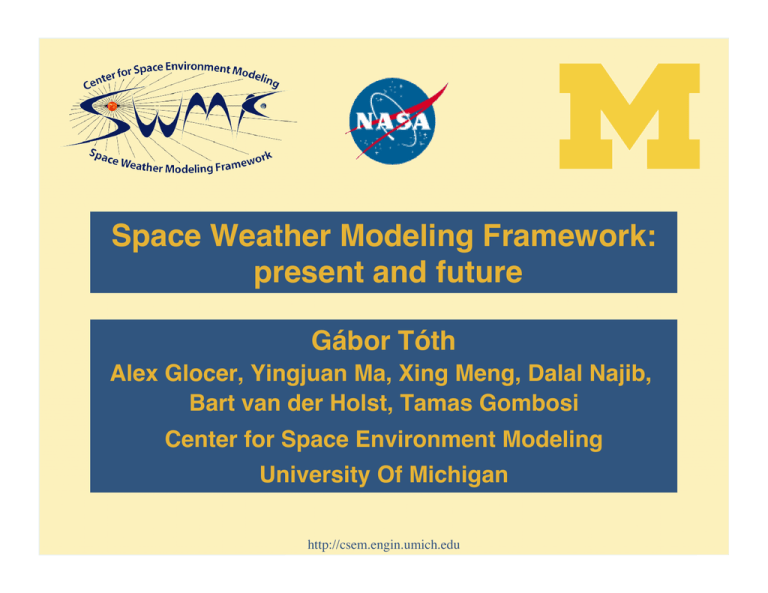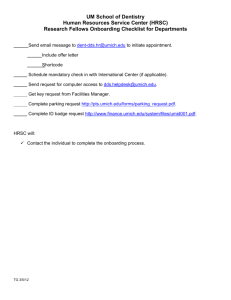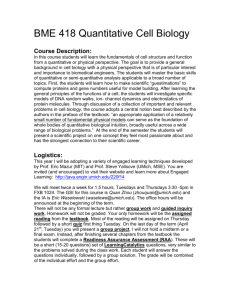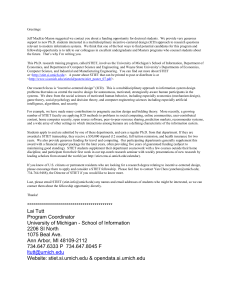Document 10616960
advertisement

Space Weather Modeling Framework: present and future Gábor Tóth Alex Glocer, Yingjuan Ma, Xing Meng, Dalal Najib, Bart van der Holst, Tamas Gombosi Center for Space Environment Modeling University Of Michigan http://csem.engin.umich.edu Outline Space Weather Modeling Framework Present and future models Present and future physics in BATSRUS Hall MHD Multi-ion MHD MHD with non-isotropic pressure Summary http://csem.engin.umich.edu 2 The Challenge of Scales Temporal scale: ~228 ≈ 2.5x108 Length scale: ~228 ≈ 2.5x108 Volume ratio: ~284 ≈ 2x1025 http://csem.engin.umich.edu 3 From Codes To Framework The Sun-Earth system consists of many different interconnecting domains that are independently modeled. Each physics domain model is a separate application, which has its own optimal mathematical and numerical representation. Our goal is to integrate models into a flexible software framework. The framework incorporates physics models with minimal changes. The framework can be extended with new components. The performance of a well designed framework can supercede monolithic codes or ad hoc couplings of models. http://csem.engin.umich.edu 4 Space Weather Modeling Framework SWMF is freely Toth: Multi-Ion MHD available at http://csem.engin.umich.edu and via CCMC 5 http://csem.engin.umich.edu Physics & Empirical Models in SWMF Physics Domain 1. Solar Corona ID SC Eruptive Event Generator 3. Inner Heliosphere EE IH BATS-R-US / breakout, TD, GL BATS-R-US OH SP GM IM IE BATS-R-US Kóta & FLAMPA BATS-R-US / Tsyganenko RCM, CRCM, HEIDI, RAM+SCB RIM / Weimer 9. Upper Atmosphere 10. Radiation Belt 11. Polar Wind UA RB PW GITM / MSIS, IRI RBE PWOM 12. Plasmasphere PS LA DGCPM SOCOL 2. 4. 5. 6. 7. 8. Outer Heliosphere Solar Energetic Particles Global Magnetosphere Inner Magnetosphere Ionosphere Electrodynamics 13. Lower Atmosphere Toth: SWMF Physics / Empirical Models BATS-R-US Orange: under development 6 The SWMF Architecture Toth: SWMF http://csem.engin.umich.edu 7 Parallel Layout and Execution LAYOUT.in for 20 PE-s ID ROOT SC/IH GM IM/IE LAST STRIDE #COMPONENTMAP SC 0 9 1 IH 0 9 1 GM 10 17 1 IE 18 19 1 IM 19 19 1 #END 8 Performance of the SWMF 9 Parameter Editor GUI Toth: SWMF & BATS-R-US http://csem.engin.umich.edu 10 SWMF Code Summary Source code: 250,000 lines of Fortran in the currently used physics and empirical models 34,000 lines of Fortran 90 in the core of the SWMF 22,000 lines of Perl and shell scripts 20,000 lines of IDL plotting scripts 13,000 lines of Fortran 90 in the wrappers and couplers 10,000 lines of Makefiles 8,000 lines of XML description of input parameters 6,000 lines of PHP scripts in the SWMF GUI User manual with example runs and full documentation of input parameters Fully automated nightly testing on 7 different machine/compiler combinations SWMF runs on any Unix/Linux based system with a Fortran 90 compiler, MPI library, and Perl interpreter SWMF can run on a laptop with one or two components and scales well to several hundreds or even thousands of processors of the world’s fastest supercomputers with all components running together. http://csem.engin.umich.edu 11 75 SWMF tests 60 BATSRUS tests BATS-R-US Block Adaptive Tree Solar-wind Roe Upwind Scheme Physics Classical, semi-relativistic and Hall MHD Multi-species, multi-fluid, anisotropic pressure Radiation hydrodynamics with multigroup diffusion Multi-material, non-ideal equation of state Solar wind turbulence, Alfven wave heating Numerics Conservative finite-volume discretization Parallel block-adaptive grid Cartesian and generalized coordinates Splitting the magnetic field into B0 + B1 Divergence B control: 8-wave, CT, projection, parabolic/hyperbolic Shock-capturing TVD schemes: Rusanov, HLLE, AW, Roe, HLLD Explicit, point-implicit, semi-implicit, fully implicit time stepping Applications Sun, heliosphere, magnetospheres, unmagnetized planets, moons, comets… 100,000+ lines of Fortran 90 code with MPI parallelization http://csem.engin.umich.edu 13 Hall MHD Hall physics can play a critical role in collisionless magnetic reconnection. Physically, the Hall term decouples the ion and electron motion on length scales comparable to the ion inertial length (δ = c/ωpi = VA/Ωci). In essence, the electrons remain magnetized while the ions become unmagnetized. Full particle codes are expensive and/or noisy (3D time dependent). The GEM reconnection challenge (Birn et al., JGR, 106, 3715, 2001) concluded that Hall physics is the minimum physics needed to achieve fast reconnection. http://csem.engin.umich.edu D MH e v i ist Res GEM Challenge simulation with BATS-R-US 14 Hall MHD Equations Electron inertia and pressure are neglected for now Astronum 2008 http://csem.engin.umich.edu 15 Algorithmic Challenges in Hall MHD The fastest wave speed is the Whistler wave speed, estimated as so the stability (CFL) condition for explicit schemes becomes: Implicit time stepping is necessary for 3D time-accurate simulations when we are not interested in modeling the shortest wavelength Whistler waves, and want to do simulations with much longer dynamic time scales. http://csem.engin.umich.edu 16 Explicit/Implicit Scheme (Toth et al. JCP, 2006) Fully implicit scheme has no limitation on the time step, but each iteration is expensive typically 20-30 times more than explicit time step Fully explicit is inexpensive for one iteration, but numerical stability limit can results in a very small time step Set time step based on accuracy requirement: Solve blocks with unrestrictive stability condition explicitly Solve blocks with restrictive stability condition implicitly Load balance explicit and implicit blocks separately http://csem.engin.umich.edu 17 Parallel Scaling for Hall MHD Grid: 4848 blocks with 8x8x8 cells (2.5 million cells) ranging from 8 to 1/16 RE. Simulations done on an SGI Altix machine. http://csem.engin.umich.edu 18 Grid for Magnetosphere Run 71,000 blocks with 4x4x4 cells ranging from 8 to 1/32 RE Refined at dayside magnetopause and tail reconnection http://csem.engin.umich.edu 19 “Steady State” Hall MHD Solution Local time stepping does not converge to a true steady state: Solution is time dependent! http://csem.engin.umich.edu 20 Hall MHD Magnetosphere Simulation 4804 blocks with 8x8x8 cells (total 2.5 million cells) ranging from 8 to 1/16 RE. Solution shows blobs of plasma detaching in the tailward direction. Time scale is a few minutes. http://csem.engin.umich.edu 21 1D cut near X-point Hall MHD simulation Astronum 2008 http://csem.engin.umich.edu 4 RE Wind satellite observations Oieroset et al. Nature 412, 26 (2001) 1/4 RE 22 Cassini T9 Flyby at Titan (Ma et al, GRL 2007) http://csem.engin.umich.edu 23 Comparison of Measured and Modeled Magnetic Fields for Cassini Titan T9 flyby (Ma et al, GRL 2007) • Steady state simulation on spherical grid with multi-species (Hall) MHD. • Hall MHD result (solid line) matches observations (magenta line) significantly better than ideal MHD simulation (dashed line). http://csem.engin.umich.edu 24 Anisotropic MHD What is it? Different pressures parallel and perpendicular to the magnetic field Where does it matter in space physics? Reconnection Magnetosphere Inner magnetosphere Solar wind heating http://csem.engin.umich.edu 25 Resistive MHD electrons Resistive Resistive MHD with with MHD electrons and anisotropic ion pressure Mass conservation: Momentum: Induction: Pressure: Electron pressure: Electric field: Current: http://csem.engin.umich.edu 26 Alfven waves with anisotropic pressure Circularly polarized Alfven wave propagates at This can become unstable if the parallel pressure is large enough! http://csem.engin.umich.edu 27 Limiting the Anisotropy Instabilities Fire-hose: Mirror: Proton cyclotron: In unstable regions we reduce anisotropy so it becomes stable Ion-ion, ion-electron and/or wave-ion interactions: Push ion pressure towards isotropic distribution with time rate τ http://csem.engin.umich.edu 28 Idealized Steady Magnetosphere Run • BATS-R-US only, dipole axis aligned with Z • Steady solar wind: n = 5 /cc, v = 400 km/s, BZ = -5 nT Solve for energy and parallel pressure near bow shock Enforce stability conditions Relaxation rate towards isotropy: τ = 20 s • • • http://csem.engin.umich.edu 29 Anisotropic MHD Applications Reconnection studies (combined with Hall MHD) GEM challenge Magnetospheric simulations: Xing Meng’s poster Quiet time and storm time Comparison with data (e.g. Cluster, Themis) Coupling with inner magnetosphere models HEIDI, CRCM and RAM-SCB resolve pitch angle Solar corona modeling Solar wind heating is an anisotropic process http://csem.engin.umich.edu 30 Multi-Fluid MHD Each fluid has separate densities, velocities and temperatures. Multi-Fluid MHD has many space physics applications ionospheric outflow: coupling with PWOM Earth magnetosphere (Glocer et al, 2009, JGR) Martian ionosphere Outer Heliosphere (Opher et al, 2009, Nature) Fluids are coupled by collisions, charge exchange and chemical reactions. Ion fluids are coupled by the magnetic field. BATS-R-US now contains a general multi-fluid solver with arbitrary number of ion and neutral fluids. http://csem.engin.umich.edu 31 Multi-Fluid Magnetosphere Simulations (Glocer et al, 2009, JGR) Modeling two magnetic storms May 4, 1998 March 31, 2001 Multi-fluid BATS-R-US running in the SWMF coupled with Polar Wind Outflow Model Ridley Ionosphere-electrodynamics Model Rice Convection Model (inner magnetosphere) Comparison with single fluid model global indexes (Dst, CPCP) in situ satellite measurements http://csem.engin.umich.edu 32 O+/H+ Ratio for March 31 Storm Multi-Fluid vs. Multi-species Similar near Earth Different further away http://csem.engin.umich.edu 33 Magnetic Field vs Goes 8 Satellite Multi-fluid MHD with O+ outflow Single-fluid MHD with no outflow http://csem.engin.umich.edu 34 Velocities vs Cluster Satellite http://csem.engin.umich.edu 35 Velocity Differences and Magnetic Field http://csem.engin.umich.edu 36 O+ Escape from Mars Ionosphere Multi-fluid MHD Multi-species MHD http://csem.engin.umich.edu 37 Summary SWMF is a mature tool for space physics and space weather Expanding dynamically with new components and physics models Used for ever increasing number of space physics applications Publically available source code with all models included Available via CCMC for runs on request BATSRUS is an efficient and flexible MHD++ code Flexible: dozens of applications, multiple equations Adaptive in space: block adaptive generalized coordinate grid Adaptive in time: explicit, (semi- and point-)implicit time discretizations Efficient: scales to thousands of cores The SWMF development is driven by improvements of existing algorithms and by new applications. http://csem.engin.umich.edu 38






